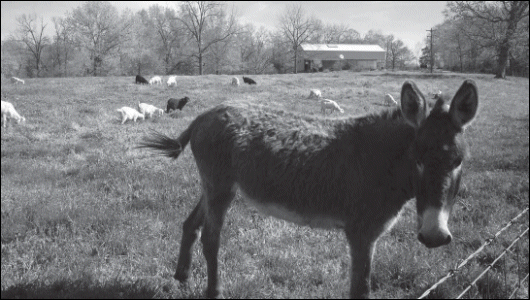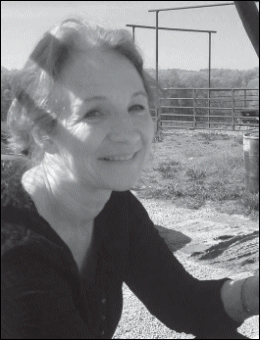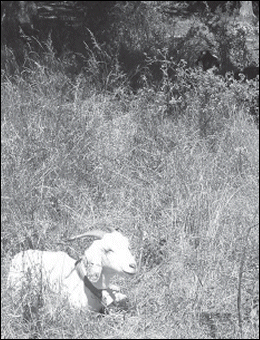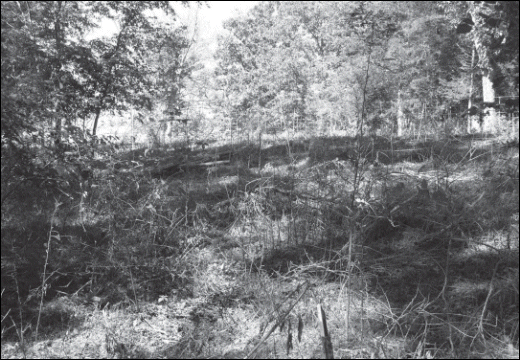Green Horizons
Volume 17, Number 2Summer 2013
By Katie Moritz, MU Center for Agroforestry Intern
 |
| A donkey, a natural guardian against predators, protects a bunch of baby goats on Busby Farm. Credit: Katie Moritz |
One efficient method to clear invasive plant species from woodlands turns out to have four legs, an insatiable appetite and a very low environmental impact, according to a local scientist's findings. Since the fall of 2011, Dr. Charlotte Clifford-Rathert, DVM, an assistant professor at Lincoln University in Jefferson City since 2007, has been studying the use of goats to restore native grasses in woodlands at the school's 280-acre Busby Farm, Missouri's largest organic research farm.
She's found this system is beneficial for the goats and the land. "This is a perfect place for goats," Clifford-Rathert said. "Instead of mechanically clearing you can use goats for less of an impact on the environment. I'm really anxious for the next two years to show, 'See? it really does work.'"
 |
| Charlotte Clifford-Rathert at Busby Farm in Jefferson City. Credit: Katie Moritz |
To conduct the three-year study, Clifford-Rathert partitioned the farm's 42 acres of woodland into six, seven-acre blocks. Three of the six seven-acre woodland blocks will be left ungrazed. The other three seven-acre blocks will each be partitioned into 7, one-acre paddocks, and rotationally grazed by goats. The goats munch on invasive species such as multiflora rose and Japanese honeysuckle, leaving the forest floor weed free and able to regrow native plants. Clifford-Rathert and her team of two helpers plus student farm workers move goats from acre to acre every four to seven days and study the effects the goats have on the woodlands.
For the first 10 days of the study each year - it usually begins May 1 - the goats wear GPS-enabled pedometers to track their movements. Clifford-Rathert wants to determine if the goats graze in patterns. "We want to see if they follow the same path as last year, if each year they remember where the plants are," she said. The research team observes the land and goats closely, monitoring weight gain and loss and intestinal parasites in the goats and soil fertility and compaction.
The grazing has cleaned up the forest floor, seriously diminishing invasive plants, and the goats have far less parasites than if they had been grazing traditionally, Clifford-Rathert said.
 |
| One of Clifford-Rathertís goats lays just outside the woodlands while another munches on foliage in the background. Credit: Katie Moritz |
"As long as they're eating the brush, they're not reingesting fecal material on the ground," she said. "When the goats eat brush this keeps their heads up and prevents them from eating off the ground, reingesting parasite larva on the grass."
Learning about the effects of woodland grazing has several benefits, she said. Farmers can make money on a wood crop by making their woodlands usable. Clifford-Rathert said farmers could get a good wood crop every 10 to 15 years, with a meat crop in between, when utilizing managed intensive grazing with goats.
Cleaning up woodlands also diminishes the risk for forest fires, Clifford-Rathert said.
She said the U.S. Department of Agriculture was interested in her research because it could provide solutions to forest fire problems. The USDA provided the grant for the project. "If that stuff is all gone, there's no fuel to the fire," she said.
In addition to benefiting farmers and providing a fix for forest fires, carefully managed woodland grazing can serve as a tool to restore the woods to a more natural state. Clifford-Rathert said she's become very excited about the work she's doing at Busby Farm.
"It's my passion; it's really become what I get up in the morning to do," she said. "I see the potential, one year later, two years later, three years later. I can't wait for it."
 |  |
 |
| The same patch of woodland over the course of a few days. It is part of a one-third-acre area where 14, 6-month-old male goats grazed and quickly cleaned up. Photo Credit: Charlotte Clifford-Rathert |
Editors' note:
Goat silvopasture is best suited to extremely altered forest ecosystems with many exotics and few natives. Controlled grazing with goats will enable the landowner to control invasive species but if not carefully managed, may also have less desired woodland impacts. For example, goats and other livestock will eat desirable oak seedlings needed for regeneration of the future forest. Elimination of native midstory vegetation may reduce certain wildlife benefits.
Regardless of livestock type, unregulated grazing in the woods can cause damage to desirable trees and understory vegetation, and can also create erosion problems.
Consult with a professional forester to determine if this is a good plan for your woods and work with a grazing specialist to design a system that will meet your objectives.